The iPhone 5 Review
by Anand Lal Shimpi, Brian Klug & Vivek Gowri on October 16, 2012 11:33 AM EST- Posted in
- Smartphones
- Apple
- Mobile
- iPhone 5
Display: Now 16:9 with full sRGB Coverage
Section by Brian Klug
A huge part of the story of what’s new in the iPhone 5 is obviously the display. At a high level what’s different is pretty simple sounding: aspect ratio is now 16:9, resolution is 1136 x 640, gamut coverage is now almost exactly sRGB, and the digitizer is now in-cell as opposed to on-cell. Let’s go through those changes.
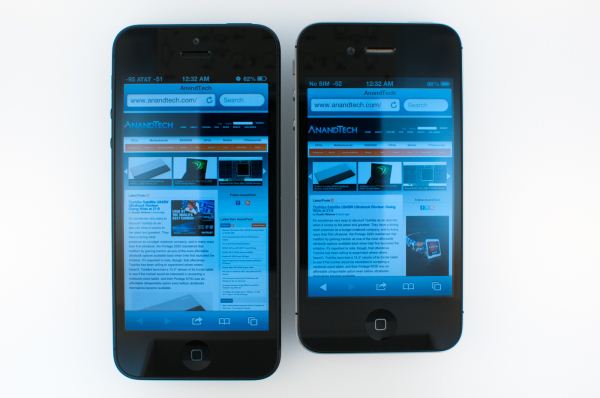
iPhone 5 (left), iPhone 4S (right)
Since the original iPhone days, aspect ratio for the phone has been an immutable 3:2, and later on the iPad adopted an aspect ratio of 4:3. All the while, the aspect ratio wars for content and media have been warring, and by now it’s obvious that 16:9 has won. YouTube changed over to 16:9 just a year after the original iPhone launch, and since then other sources of content have moved that way as well. We saw 16:9 take over as the dominant HD format, and like it or not the same has played out on the PC with a march from 4:3 to 16:10 to 16:9. The move to 16:9 for the iPhone now enables most modern video content to play back without (or with very little) letterboxing, and simultaneously expands the viewport a considerable amount for other applications. A huge number of iOS applications are essentially a list view or a tabbed view with a list down below, and thus are immediately suited in portrait rotation to take advantage of more vertical space. I spend most of my time in portrait mode with rotation locked on iOS, and increasingly it seems as though landscape rotation is a marginalized view for application developers, so this seems to be a sound path forward.
The route Apple chose to get the iPhone to 16:9 is now widely known. They kept width the same at 640 pixels and roughly 5 cm, and instead opted to make the display taller, at 1136 pixels and roughly 8.85 cm, up from 960 pixels and 7.39 cm on the iPhone 4/4S. Interestingly enough 1136 isn’t exactly 16:9, a closer target would be 1137, but we’re talking about one or two pixels that simply get cropped out on video decode and display for most media.
I’ve talked about how Android is now an almost entirely 16:9 camp, and that really frames my thoughts about the iPhone 5’s display size change. In the past, switching back and forth between iOS which was 3:2 previously and modern Android handsets that were 16:9 never felt very extreme. There was a noticeable difference in overall size, sure, but aspect ratio never quite made that big of an impression on me considering the differences in OS. After spending a lot of time with the iPhone 5’s 4-inch, 16:9 display, switching back to the original iPhone format’s 3.5-inch, 3:2 display is a downright jarring experience. It’s readily apparent just how much the platform needed this change in both aspect ratio and size, if nothing else to compete with increasingly larger and larger consumer expectations for display size. It’s interesting as well how discussion about thumb radius sweeping a semicircle out from the bottom corners of the display also quieted down with the change. We’ve talked in the past about how the typical smartphone grip isn’t really centered around the bottom but rather shifted up slightly. I don’t find that the iPhone 5’s larger display changes or diminishes one-handed use significantly at all.
Apple has of course made changes to iOS to accommodate the change in aspect ratio, and those first party applications take advantage of the 176 extra vertical pixels. For starters, the landscape keyboard gets wider keys but doesn’t quite fill up the whole 1136 wide canvas. There’s also another row for applications on homescreens, and another row inside folders.
For third party applications however that road to 16:9 for the iPhone 5 and newest iPod Touch display requires some tweaking, and a trip through the App Store approval process, otherwise you end up with letterboxing. There’s really nothing else that Apple could’ve done besides letterboxing to accommodate older apps that either aren’t updated or will never be updated, but the downside of this centered letterboxed experience is that it shifts portrait apps and the keyboard up by 88 pixels.
A great example of where this is jarring is the IM application I use, imo.im, which hasn’t been updated as of this writing to take advantage of the new viewport size. As a result, typing on this 88-pixel-shifted keyboard requires repositioning one’s grip. This is a temporary grievance though that will go away in time as developers update things, but still warrants mentioning. It’s similar to but not identical to the same kind of friction we saw with the path to retina-enabled apps with the iPhone 4 launch.
In-Cell
The next major improvement is in-cell touch. The iPhone 5 isn’t the first smartphone to include an in-cell touch LCD, but perhaps the first where we’ve seen lots of talk about it. Part of getting to even thinner form factors is either eliminating or reducing the thickness of everything in the z direction. In addition, increasing the light throughput of the display stack (which means both filters and everything between the backlight LEDs and your eye) is a huge driver for overall battery life, since the display is still by far the largest consumer of precious milliwatts in a smartphone.
One of those things is the digitizer, which previously sat on top of the LCD as a separate layer incurring both additional thickness and back reflections. While successive generations of both iPhone display stacks (and the smartphone platform in general) have eliminated a lot of back reflections by reducing the number of air-glass interfaces with optical-grade adhesive lamination (and thus 4 percent Fresnel reflections that go along with each of them), ultimately these glass-adhesive interfaces still incur some path loss and still have a z profile. The only way to reduce these further is to go to in-cell touch, which really is a fancy way of saying that the digitizer is then integrated into the LCD-TFT gating itself, and thus into the cells of each pixel, rather than as a discrete layer atop the stack after color filters.
Getting to this level of integration requires cooperation between both the display driver and touch sensor, and herein lies the challenging engineering problem that in-cell touch poses. Touch sensing has to be time multiplexed with display driving otherwise the touch signal might be entirely lost in noise. At the same time, touch sensing is often around double the frequency (120–175 Hz) of display drawing (60 Hz), so this has to be done carefully during quiet periods, and thus that required communication and integration. The iPhone 5 uses a combination of TI and Broadcom controllers to do display controller and touch sensing, where previous generations of iPhone simply just used a single chip TI solution. In future generations this will come back down to just being a single-chip solution.
Subjectively thus far I haven’t detected any change in tracking quality or performance with the iPhone 5’s in-cell solution, which is great. To end users the difference seems to be totally transparent.
In addition to just the air-adhesive interfaces introducing thickness and unavoidable Fresnel reflections, there’s also the traces from transparent conductors in the digitizer as well to think about. At present that material is Indium Tin Oxide (ITO), which is one of very few known transparent conductors and used inside every LCD. Because Indium is a relatively expensive rare earth metal, ITO traces are only laid down where they need to be on top of and below the glass substrate (for both transmit and receive layers of the digitizer), and the areas inbetween those traces are then filled with an index-matching space fill material to diminish their visibility. How well this space fill is done and how close the index is to ITO’s is one of the quality metrics of a digitizer to begin with, and often these rows and columns are visible under direct illumination either outdoors or with good eyes indoors. Often you can tell a lot about how much value an OEM placed on its entire digitizer just by how distracting these are outdoors, but the big benefit with in-cell is that they go away entirely, which is a huge gain I rarely see people talking about in the context of in-cell improvements.
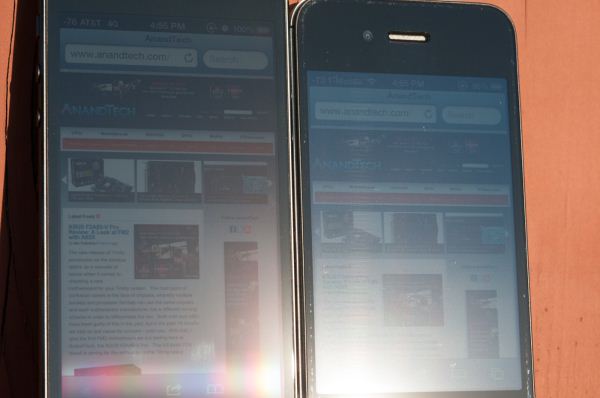
Horizontal lines on the iPhone 4S (right) from the digitizer (easier to see at full size)
That change leads to what I would consider a huge improvement in outdoor visibility, since these lines are now totally gone on the iPhone 5. In addition, there’s no longer a contrast-diminishing set of back reflections from the extra glass layer when outdoors. This is very visible in the photos I’ve taken showing outdoor viewing behavior on both the iPhone 4S and iPhone 5.

Significantly less blue haze on the iPhone 5 (left) than iPhone 4S (right)
Display Quality
Our own Chris Heinonen already did an excellent job characterizing the iPhone 5 display using our new CalMAN 5 based test suite he put together, and I’d encourage everyone to read that for a much more comprehensive version of an iPhone 5 display analysis. There’s really not a whole lot for me to add other than some results from the two other main smartphone displays I’ve tested with this new workflow, and some graphs with data from other phones. Chris has better instrumentation than I do with an i1Pro, but we’ve tweaked the workflow slightly so I ran the iPhone 5 and 4S through the test. In addition Apple has multiple suppliers for the iPhone 5 display so there are bound to be some differences in devices.
Subpixel geometry and size is still the same on the iPhone 5, meaning this is still a “retina” display and all the usual discussion about angular subtense and visual acuity still applies. You can see this under the microscope (all these images are at the same magnification, focus is a bit different though given the different optical path length thanks to that in-cell touch) — both the geometry and pixel pitch are unchanged between the 4S and 5.
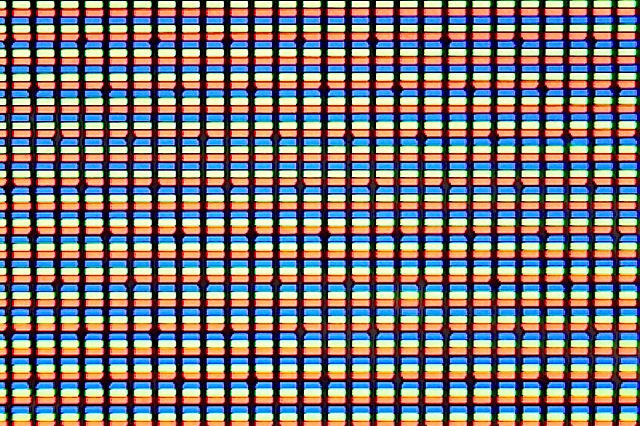
To start are our brightness and contrast graphs which are measured at 100 percent brightness. The iPhone is even brighter than the iPhone 4 and 4S displays, at just over 600 nits on my unit. I saw some variance back between the iPhone 4 and 4S in brightness, so depending on where you’re coming from this can be a noticeable jump. Apple started off with good consistency when the iPhone 4 came out, but I saw lots of white point and luminance variance with that form factor display as time progressed and we moved from the 4 GSM to 4 CDMA to 4S.
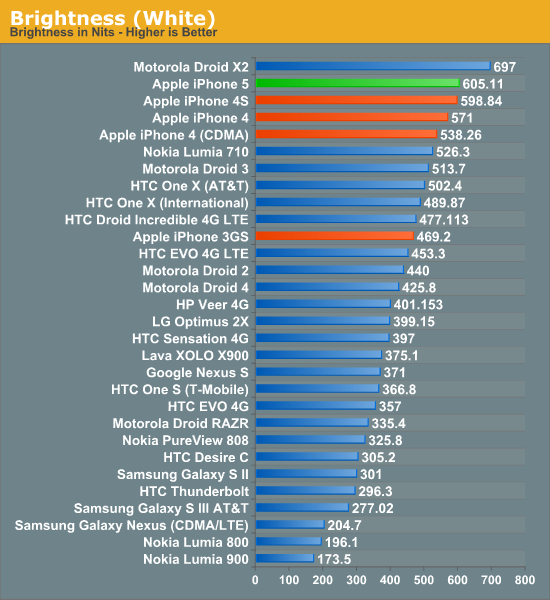
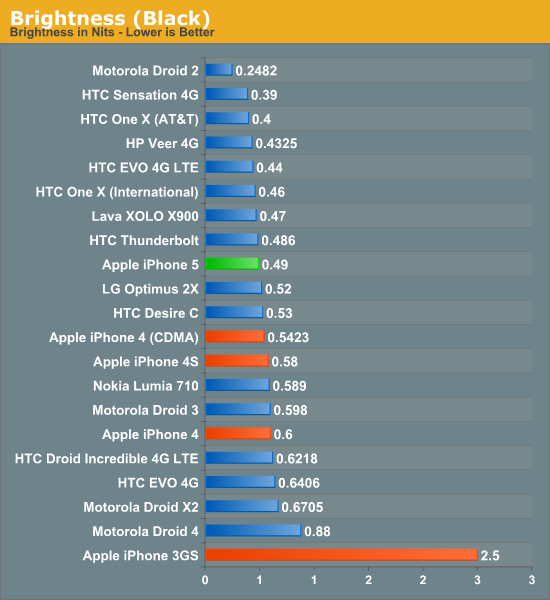
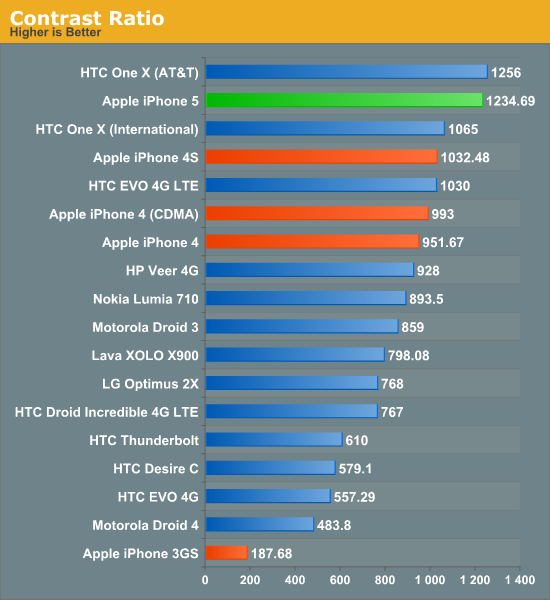
When it comes to gamut, Apple announced that the iPhone 5 display has full sRGB coverage. The iPad 3 was actually first in Apple’s lineup to advertise roughly full sRGB coverage, but it appears that the iPhone 5 is even closer to being spot on. Using our new CalMAN workflow we can easily measure and compare the overall saturations for primaries and secondaries, the ideal values of which are represented by white boxes. There’s a whole lot of measuring required for each phone, so I pared it down to just the iPhone 5, 4S, HTC One X, and Galaxy S 3 for the moment.
Saturations and Gamut
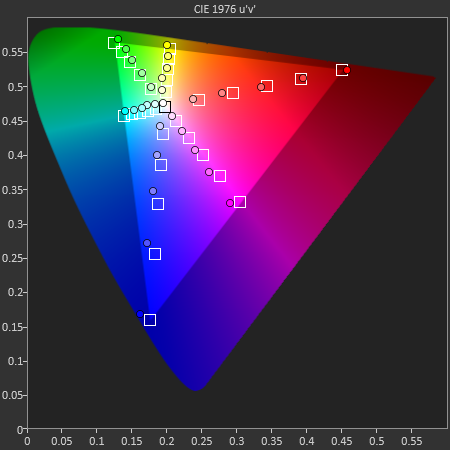
The iPhone 5 is, like Chris said already, the closest smartphone I’ve seen to sRGB to date. It’s really clear to me that Apple puts a strong emphasis on its suppliers to both deliver a display capable of hitting that gamut, and then bothers to do some factory level calibration to get reasonably close. I’ve seen this drift over time but for the time being the iPhone 5 is quite close to being ideal all things considered.
The GretagMacbeth ColorChecker card test colors are next up, and it isn’t surprising here to see some variance, but the values from the iPhone 5 are very close to the intended colors compared to the competition and its predecessor.
GMB Color Checker
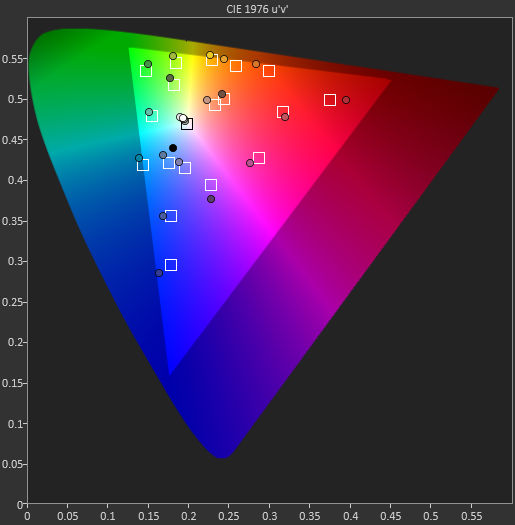
Grayscale and gamma represents our steps of 5 percent grey from 0 to 100 and we get a report for contrast, the white and black levels, color temperature, gamma, and average Delta E 2000 here.
Grayscale and Gamma
My values differ from Chris’ slightly, but my instrumentation and phone are both different from his which may explain some of the differences. The high level story is the same though, the iPhone 5 tracks closer to the ideal than any of the other devices. I’ve also gone ahead and made a table with the average Delta E from each step.
| CalMAN Display Comparison | |||||||
| Metric | iPhone 5 | iPhone 4S | HTC One X | Samsung Galaxy S 3 | |||
| Grayscale 200nits Avg dE2000 | 3.564 | 6.162 | 6.609 | 4.578 | |||
| CCT Avg (K) | 6925 | 7171 | 5944 | 6809 | |||
| Saturation Sweep Avg dE2000 | 3.591 | 8.787 | 5.066 | 5.460 | |||
| GMB ColorChecker Avg dE2000 | 4.747 | 6.328 | 6.963 | 7.322 | |||
Last up is the indoor viewing angles comparison between the iPhone 5 and the 4S, which are essentially unchanged. Even at extreme angles I can’t detect any major differences in viewing angle between the 4S and the 5, which is a good thing since there isn’t really anything to complain about.


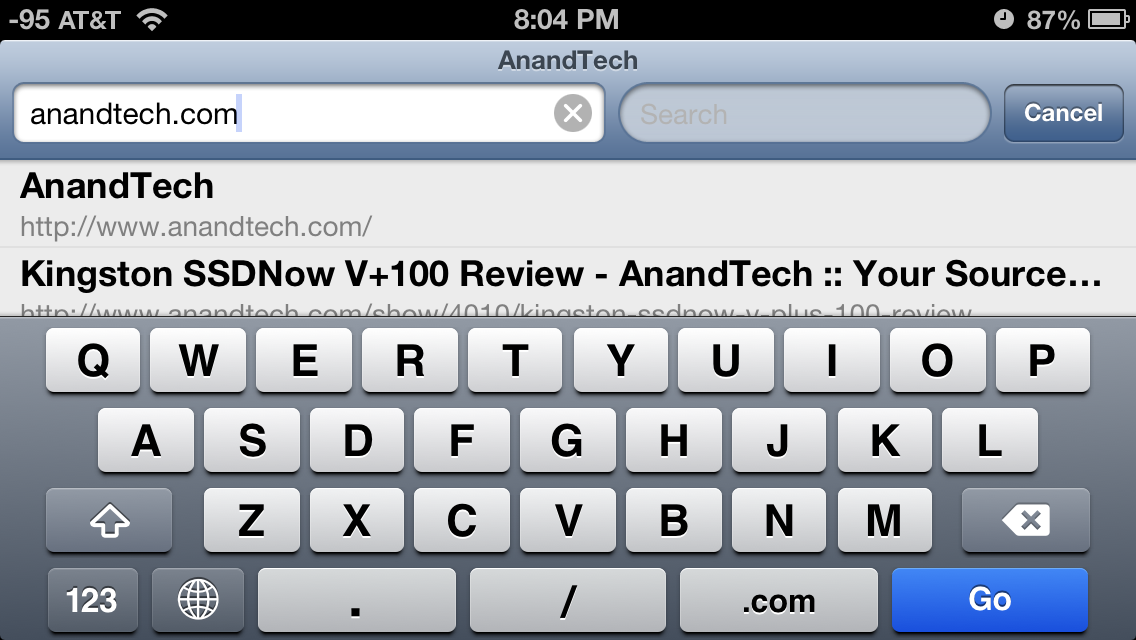
















276 Comments
View All Comments
name99 - Wednesday, October 17, 2012 - link
If you want to read non-technical reviews, there are a million other sites you can go to, from NYT and WSJ to Engadget and TheVerge.The WHOLE POINT of people reading Anand's reviews is to get tech details we don't get elsewhere.
Perhaps as a followup you might want to suggest that John Siracusa in future limit his OSX reviews to a single letter-sized page?
rarson - Wednesday, October 17, 2012 - link
No, it's not the "WHOLE POINT," the whole point is that reviews are reviews and tech articles are tech articles.GotThumbs - Tuesday, October 16, 2012 - link
"Those longing for an HTC One X or Galaxy S 3 sized device running iOS are out of luck. "I find it hard to believe there is even one person that is in this group. Apple's walled garden is mostly OS and portal based (Itunes).
Especially with Apples maps being sub-standard.
Please stick to facts.
A5 - Tuesday, October 16, 2012 - link
If you don't want any editorial judgement or statements, there are plenty of places where you can just read a spec sheet and benchmark results.Omophorus - Tuesday, October 16, 2012 - link
I think the opposite is more likely... or at least I fall into that category.Mobile computing device aside, Android 4.0+ is shockingly much nicer to use (and this coming from a long time iPhone user) than iOS 5 or iOS6.
If I could get the iPhone 5 handset, maybe with slightly better anodization, running Android 4.0+ I'd be in hog heaven.
After playing with an iPhone 5, I really dig the hardware, but found the software woefully lacking.
crankerchick - Tuesday, October 16, 2012 - link
I think you and the original commenter missed what the statement was saying. It said, "HTC One X or Galaxy S3 'sized' device..."Specifically, a larger screen iPhone, is where I think they were going with the statement, especially given the context of the paragraph where the statement was made.
That said, I'm very much in the same camp as you. My number one device would be an iPhone-size and iPhone-build device running Android (but with a few tweaks since we are talking the ideal device). In fact, that is part of the reason I have an iPhone now and my Galaxy Nexus is sitting in a drawer by the bed--it's just too big and battery life is awful. I want a 4-4.2" 720p screen that doesn't have last year's hardware inside. The One S comes closest, but it's not on VZW to my knowledge, and it's still not "the best" hardware available, which you need with Android, especially on a manufacturer's skinned device.
perpetualdark - Monday, October 22, 2012 - link
What about the Incredible 4g? I think this phone was overlooked because of it's proximity to the S3 release and the fact that the market is generally trending toward a nearly 5" display..I like this phone because it has the current generation of technology, is pretty darn thin, has a replaceable battery, has the 4" display (ie I am not holding a small tablet to my ear or carrying it in my pocket), and is, more importantly, android.
Yes, the SLCD display may not be quite what the apple display is on paper, but to be perfectly honest, I have never noticed the differences.. Perhaps in a test environment, or to someone who calibrates displays all day, the Apple display would be better, I just don't see it.
The s4 processor is not only fast, but plenty efficient, and the battery lasts easily 2 full days of heavy use. I can use it to read a kindle book for 6-8 hours over 2 days, talk a few hours, surf the web a few dozen times, text a few hundred texts, and even play games for an hour or two before I run out of battery. I have yet to go below 40% in one 24 hour period of time with the exception of using it with GPS and maps up.. the gps on 100% burns up the battery fast.
gig of ram, 8 gigs on board storage, 32 more gigs with the sd card, etc, plenty of storage. 8 megapixal camera on back and a vga camera on front.
ICS, LTE, Beats Audio, pretty much all the latest in tech..
No, it can't quite compete with the S3, but it is pretty close to a One X in a 4" package and the closest thing to a One X you can get from Verizon, and honestly the phone that SHOULD be compared to the iphone5, given it is the only one with the current generation of hardware that is the same size. Sure, the iphone5 has an edge on the inc 4g in terms of tech specs, but when you add cost to the mix, the playing field is more level there as well, and to be honest, in real world applications the differences are going to amount to very small percentages.
What people really want is a phone that fits their needs. Usually the most important things are screen size, OS preference, cost, and battery life. Performance is ONLY an issue when there is a problem with it.. Like when the iphone 4 dropped calls and couldn't do internet when you touched it.. The difference from the S4 to the A6 in real world application is a second or two in loading an app.. if even that.. most of my apps open instantly and with chrome and a good 4G connection I am betting that side by side loading web pages would be nearly identical. Specs are cool when comparing e-peen size but otherwise don't mean much in application.
Not everyone is interested in big screens for a phone. Not everyone is interested in having a flexible OS. Not everyone is interested in the latest tech. Not everyone wants to spend a fortune on a phone that is, in practice, marginally better than what they have already. Not everyone is interested in bleeding edge technology. Sometimes you are looking for the phone that best suits YOUR needs. For me, that is an android platform, small form factor to fit in my front pocket comfortably as well as in my hand. A processor that was fast but power conservative. A battery that lasted a full day with reserve to spare, and could be used for 2 or 3 days if conserved well, AND could be swapped with a fully charged battery when travelling. I also like a phone that I can drop and scratch and not notice the dings and scratches.. since I put it in my pocket, I don't want to add a bulky case to keep it safe.. (I have dropped this phone dozens of times and 24" away you would never know it). I like to only pay $6.99 for insurance and be able to replace it if lost or stolen or broken for less than $100 ($12 per month for apple with $170 replacement deductible). And I like that I can use ANY micro-usb charger or cable to charge or connect to a computer. I don't have to buy any special adapters to make it work with my existing devices.
Quite frankly, I think the difference between an android fan and an apple fan is that an android fan will not settle for the one device available to suit his needs, he will shop around to find the RIGHT one. If that happens to be an iphone, that is what he will get. But with dozens of models to choose from that are every bit as good if not better in every way that really matters, the chances of going with an iphone are pretty slim. An apple fan will settle for what is available and try to convince everyone around him that this one device will fit everyone's needs perfectly without exception.
crankerchick - Tuesday, October 16, 2012 - link
I don't follow all the technicals like that, I'm more of an end user when it comes to mobile technology, but I think the trend towards the larger screens is more the MFRs pushing that a selling point (moar moar moar) to cover the fact that they can't fit the latest and greatest and cutting edge (NFC, quad core, LTE, etc) in the chassies of a 4" screen phone.Just my hunch. Wouldn't mind being schooled on this by someone in the know.
KPOM - Tuesday, October 16, 2012 - link
I'd agree with that assessment. Apple was one of the last to move to 3G and one of the last to move to LTE because of battery life. The other manufacturers got around it by building thicker phones in the 3G era, and then with the LTE era started putting in bigger screens, which gave them room for bigger batteries (though the larger displays also required more power). It turned out enough people liked the bigger screens.Now that the power consumption levels are down, it will be interesting to see if others shrink their screens back down to Apple levels. The Galaxy SIII Mini is a half-hearted attempt, as it lacks LTE and has mediocre specs. But maybe someone else will take the bait.
rarson - Thursday, October 18, 2012 - link
I feel like the iPhone 5 screen is actually too small (and I've heard complaints that the phone is too light, which I sort of agree with as well), but I think the Galaxy S3 is too big. I'm still using a Verizon Fascinate. It's got a bigger screen than the 5, but it's a bit smaller than the S2 and S3, perfect size. Thin but not too thin, and light but not too light. In fact, all I really want is a phone exactly like it, but with more power, better battery life, and maybe a slightly better screen (can't complain too much about the screen I already have).When I picked up the Fascinate, I knew it was the phone I wanted (helps that the price was only $50). When the S2 came out, I was excited to see it but disappointed by how much bigger the phone had gotten. I don't want a phone that I have to contort to get into my pocket. Apple's iPhone 5 is great in that respect, but after using this Fascinate for so long, its small size feels a bit cramped.
I'd love to have the hardware of the Apple phone, but proprietary connectors and iOS are absolutely a no-go for me. I really don't care for iOS at all, because Android is so much easier to use.